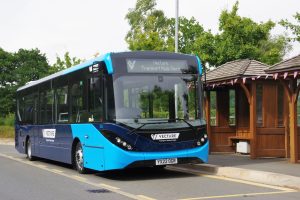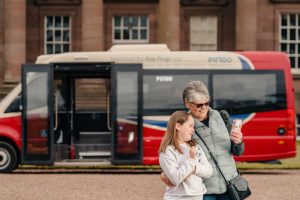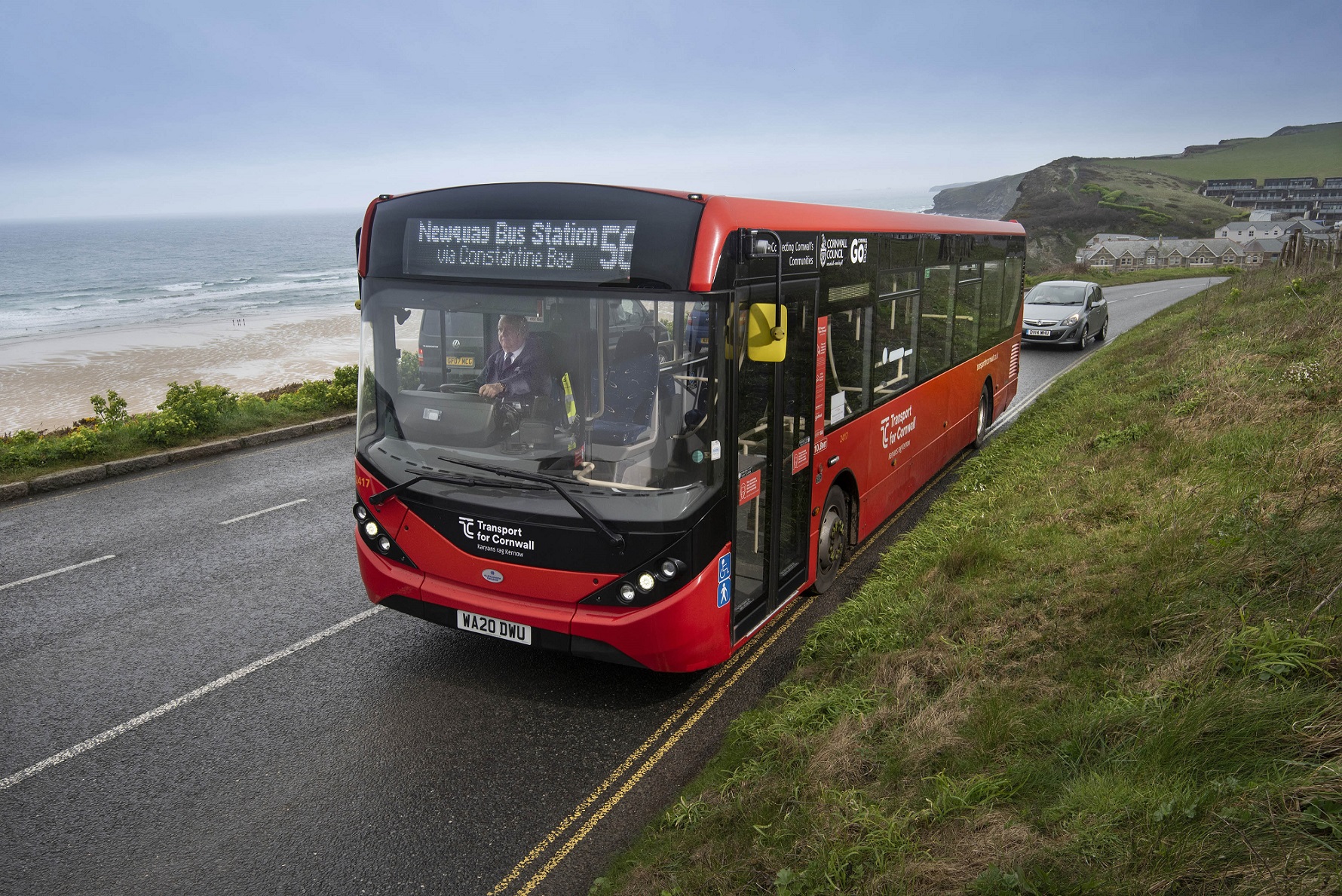Key industry figures give their views on the parts played by funding, DRT, collaboration and innovation in keeping buses running in rural areas
Barely a day goes by without news of bus services being cut, and rural services have been particularly hard hit. A report commissioned by the County Councils Network (CCN) and published this year found that, from 2010 to 2022, total bus miles in England reduced by 26.5% in the jurisdictions of its member councils – compared to 19.1% across the whole country on average. CCN blamed this on a claimed lack of Bus Service Improvement Plan funding for these areas compared to towns and cities.
The changes in travel habits since the onset of the COVID-19 pandemic have had a significant impact on all services, but it appears the more remote areas have been worst affected.
Becka Steven, Confederation of Passenger Transport (CPT) Senior Policy Advisor, recognises the enormity of the challenge. “Delivering efficient and effective bus services is harder in some places than others and, being born and brought up in the beautiful but sparse Scottish Highlands, I appreciate this only too well,” she says. “In rural areas, low population densities and longer distances between stops makes it more difficult to deliver bus services commercially. This has been exacerbated by local transport authority (LTA)-funded bus mileage in England being cut by over 50% in the decade before the pandemic hit – mostly due to the knock-on effect of a reduction in government funding.”
Becka believes long-term funding assurances from the government would assist, adding: “Another helpful action the UK government could take immediately would be to publish the long-awaited guidance on socially and economically necessary services.”
While acknowledging the difficulties, she stresses we “should not tolerate transport poverty” and must look for solutions. She explains that CPT will undertake research early in 2024, to “better understand what a bus network that meets the needs of bus passengers looks like in hard-to-reach areas.” It will then look at solutions and publish a toolkit for LTAs.
Thinking outside the box for rural services

Becka points out the need for innovation when it comes to rural bus services. An example of such has been promoted recently by Vectare Commercial and Operations Director Peter Nathanail. He believes a “crowdfunded” or “subscription-based” approach could work in rural areas. Vectare, which runs bus services in Leicestershire, Nottinghamshire, Cambridgeshire, Hertfordshire and Essex, is speaking to several community groups to present the concept of residents optionally paying a weekly or monthly “subscription” to have unlimited travel on a bus.
He says: “My concept is around saying, okay, as an operator we’re quite happy to provide a service, but we need to know the revenue to support that service is going to come from somewhere. There is a benefit, in my view, for a community having a bus service that extends beyond just the people within that community who may use that service – for example, if you’re a local business owner, even if you don’t travel by bus, it may still benefit your business if people can get to you.” Peter thinks that, in the right community, the idea would be feasible for a per-person charge of 50p-£1 per day.
He adds that operators need to be more creative as services’ revenues often cannot keep pace with their costs. He says local council and government funding is useful when a service can be run for a relatively low subsidy per passenger. However, he adds there is a danger that sometimes funding can lead to local authorities having control that can in cases be detrimental to the service.
DRT is not a panacea for rural
Becka stresses the commonly quoted view that demand-responsive transport (DRT) is not a “silver bullet”. She says: “A combination of timetabled services and DRT could well be a solution worth exploring in some areas to keep rural communities connected with vital services, but more work and evaluation on the viability of DRT and how schemes can be funded need to be undertaken.”
From April 2021 onwards, 12 local authorities have shared £20 million in government Rural Mobility Fund (RMF) funding for a total of 14 DRT networks. An interim report on that published last month brought useful data. For example, it showed an upward trend of usage, although this could be explained to some degree at least by the pandemic bounce-back. It found that 70% of users were female. Also interesting was that the average booking time in advance is commonly one to four days but over 13 days in the North Lincolnshire scheme.
Vectare runs two DRT networks and agrees the model can be powerful. However, Peter says other such networks have been employed when it is not the right fit for the population and area.
Dami Adebayo, Partnerships Lead at The Routing Company, which provides the technology for the Pingo networks around the UK and globally, concurs with this. He adds that getting the right routing technology is important for any network. “What we’re uniquely positioned to do is allow sharing to happen,” he says. “If two, three, four, five people request at the same time, there’s an exponential rise in potential sequences to pick them up and drop them off. It’s impossible for a human to investigate all of those potential sequences, so they’ll just pick one that might work. Most technology systems will just pick the first one that would work within certain constraints. What we do differently is we basically will consider all the options, so if there are a quintillion sequences, we pick the optimal one.”
The Pingo network in Argyll and Bute is the one that The Routing Company has supported longest in the UK, and the business claims it has been a success. Dami says: “At peak times, we’re moving 21 passengers per vehicle revenue hour, which is unheard of. On average we’re doing 4-5 per vehicle hour, which is pretty good. Ten per cent of the community’s population has downloaded the app.”
Data can be effective

DRT can be a powerful tool for operators, Dami points out. “With fixed services, from a transport planning perspective, you have to make a lot of assumptions as to where people want to travel. If you put a DRT service out there, you get actual data on where people want to go and when they want to go there.” He says DRT services can suffer when demand outstrips supply because, if there is no funding for more vehicles, customer satisfaction drops. “In those situations, you have to be quite honest with yourself and say, ‘we now know where people want to go, we can’t add any more vehicles so maybe we do need a fixed route, but one that’s going to be better designed based on that data.’”
The RMF report found DRT vehicles were empty roughly half the time, but Dami says: “From an operational standpoint, that only becomes a severe problem if you’re running the wrong size vehicle. Realistically, if you’re never going to fill a minibus, could you just use a wheelchair-accessible people-carrier instead?”
The report also noted the services were popular with younger people, even though all of them retained a telephone booking option. Dami says: “Sometimes DRT may confuse the older community, but I think it takes really good marketing and communication to make clear that the service hasn’t changed, you can still call in and make sure people know how to use it. I think that is a big challenge for the industry generally. Public transport doesn’t have many marketing experts and local authorities don’t have that capacity per se. As technology providers, we might have that capacity, but we might not understand the local context and users, so it takes a multi-stakeholder approach.”
Integration and collaboration
Becka, Peter and Dami all referred to the need for “total transport”, in which publicly funded services such as non-emergency patient transport, adult social care transport and home-to-school transport could be combined with public transport.
Peter believes DRT should integrate better with journey-planning apps such as Google Maps. “I think that’s a big missing link,” he says. “We also don’t really have DRT software that can facilitate semi-fixed, semi-flexible DRT.”
Collaboration with local businesses is one area of opportunity for operators, believes Becka. For example, a partnership between Oxford Bus Company and Le Manoir aux Quat’Saisons restaurant and hotel, owned by TV chef Raymond Blanc, has allowed for major improvements to one of its routes for the benefit of staff, visitors and diners.
That collaboration should even stretch to between operators, Stagecoach East Commercial Director David Boden argues. This year, Stagecoach’s 904 service between Huntingdon and Peterborough was able to continue by means of a partnership with Dews Coaches. Stagecoach provides the vehicles while Dews supplies the drivers.
David says: “We at Stagecoach want to provide a rural network but we recognise that sometimes other bus operators can do it with a more local ad-hoc basis. The 904 is a very strategically important service, we were losing heavily on it. We started off at £700,000 loss, took it to £500,000 loss and, with the advent of the £2 fare, down to £300,000. By bringing Dews on board, it cuts losses even further and we can build it back towards commerciality. That’s part of our commitment and working with other operators in partnership because we all want the same thing — better services for people of Cambridgeshire. It’s about thinking outside the box to do that.”
Concluding on a realistic but upbeat note, Dami thinks local bus services will always need subsidies but stresses we need to look beyond the purely commercial aspects. “The value that a rural bus service brings in terms of social impact, accessibility, giving people access to jobs, education, amenities — that value is huge in terms of reach and coverage, but it’s a success metric which isn’t highlighted enough,” he says. “Instead, it’s always stacked up against ‘what’s your farebox recovery?’ I think rural DRT services, by nature of them serving low-density areas, are rarely going to be self-sustaining and commercially viable services, but we need to celebrate the social and environmental benefits that go beyond the financial aspects.”



























